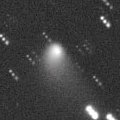
|
Now it is so bright as 9.4 mag (Nov. 24, Juan Jose Gonzalez). It keeps as bright as 9-10 mag for a long time until 2010 spring. It will be observable in good condition for a long time after this in the Northern Hemisphere. It keeps visible visually for one year until 2010 autumn.
Date(TT) R.A. (2000) Decl. Delta r Elong. m1 Best Time(A, h)
Dec. 5 12 55.44 17 35.7 2.515 2.349 69 9.3 5:23 (286, 51)
Dec. 12 13 9.13 19 29.4 2.452 2.373 73 9.3 5:28 (288, 56)
|
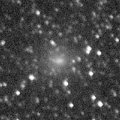
|
It reached up to 8.4 mag in October (Oct. 20, Marco Goiato). It is bright as 9.4 mag still now (Nov. 12, Marco Goiato). It keeps observable for a long time until February. It will keep 9 mag until the end of 2009. But in the Northern Hemisphere, it keeps very low after this. It locates a bit higher in the Southern Hemisphere.
Date(TT) R.A. (2000) Decl. Delta r Elong. m1 Best Time(A, h)
Dec. 5 20 19.05 -23 2.7 1.930 1.483 48 9.6 18:18 ( 42, 19)
Dec. 12 20 43.40 -21 33.5 1.990 1.514 47 9.8 18:19 ( 44, 19)
|
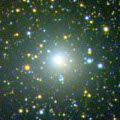
|
It reached up to 7.7 mag in summer (Aug. 13, Chris Wyatt). It is fading now, but still bright as 9.3 mag (Nov. 8, Juan Jose Gonzalez). It will be unobservable soon. In the Southern Hemisphere, it will appear in the morning sky in late February, then it keeps observable for a long time. But in the Northern Hemisphere, it is only observable in the low sky in 2010 spring, then it will never be observable again.
Date(TT) R.A. (2000) Decl. Delta r Elong. m1 Best Time(A, h)
Dec. 5 19 22.53 -14 55.1 4.175 3.450 37 10.0 18:18 ( 58, 16)
Dec. 12 19 26.24 -15 50.5 4.281 3.479 31 10.1 18:19 ( 62, 11)
|
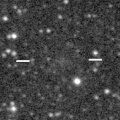
|
Although CCD observers reported it as faint as 15-16 mag, it looks bright visually as 12.9 mag (Nov. 18, Alan Hale). Juan Jose Gonzalez reported it was significantly bright as 9.2 mag on Nov. 18. It is expected to reach up to 10 mag in December. In the Southern Hemisphere, it keeps observable all through this apparition, although it becomes low in November and December. Especially, it will be observable in the excellent condition after January. In the Northern Hemisphere, it keeps observable in the evening low sky until late November when it becomes 11 mag. It will appear in the morning sky at 14 mag in late January, then it keeps observable while fading gradually.
Date(TT) R.A. (2000) Decl. Delta r Elong. m1 Best Time(A, h)
Dec. 5 19 7.12 -32 50.5 0.526 0.614 32 10.2 18:18 ( 48, 1)
Dec. 12 19 10.67 -38 49.8 0.423 0.648 28 10.2 18:19 ( 47, -7)
|
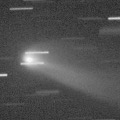
|
An outburst occured on Oct. 13, and it reached up to 8.5 mag on Oct. 15 (Toru Yusa). The central nucleus shined like a bright star, and the dust coma looked like 17P/Holmes in outburst. However, the comet returned to the normal state within a few days. Now it is 11.2 mag (Nov. 24, Juan Jose Gonzalez). It will keep 10-11 mag until December. In the Northern Hemisphere, it keeps observable in good condition for a long time until 2010 spring when it becomes fainter than 18 mag.
Date(TT) R.A. (2000) Decl. Delta r Elong. m1 Best Time(A, h)
Dec. 5 6 5.59 1 18.2 0.696 1.631 151 11.2 1:12 ( 0, 56)
Dec. 12 5 57.62 3 8.1 0.732 1.685 157 11.5 0:36 ( 0, 58)
|
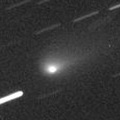
|
It has already brightened up to 10.5 mag (Nov. 24, Juan Jose Gonzalez). It will be observable bright as 9-10 mag in a good condition for a long time from winter to spring. It keeps observable until 2010 autumn when it fades down to 16 mag.
Date(TT) R.A. (2000) Decl. Delta r Elong. m1 Best Time(A, h)
Dec. 5 11 10.52 5 5.7 1.548 1.779 86 11.4 5:23 (335, 58)
Dec. 12 11 26.13 3 41.2 1.462 1.751 89 11.2 5:28 (343, 58)
|
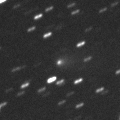
|
Now it is 13.5 mag, already visible visually (Nov. 18, Juan Jose Gonzalez). It is visible at 12 mag in winter. In the Northern Hemisphere, it keeps observable in good condition for a long time after this until 2010 spring when it fades out.
Date(TT) R.A. (2000) Decl. Delta r Elong. m1 Best Time(A, h)
Dec. 5 6 5.45 8 12.3 1.055 1.997 156 12.1 1:11 ( 0, 63)
Dec. 12 6 1.64 8 13.9 1.033 1.991 161 12.0 0:40 ( 0, 63)
|
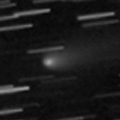
|
It has brightened much faster than expected. Now it is so bright as 12.8 mag (Nov. 24, Juan Jose Gonzalez). It is observable at 13 mag in good condition in December. It will be fading after January. It keeps observable in good condition for a long time. But it may fade out very rapidly.
Date(TT) R.A. (2000) Decl. Delta r Elong. m1 Best Time(A, h)
Dec. 5 9 37.11 3 11.4 0.653 1.332 107 13.6 4:42 ( 0, 58)
Dec. 12 9 53.15 3 30.9 0.634 1.344 110 13.6 4:30 ( 0, 58)
|

|
Outbursts occured repeatedly since September, and it keeps visible visually. It is bright as 11.9 mag still now (Nov. 24, Juan Jose Gonzalez).
Date(TT) R.A. (2000) Decl. Delta r Elong. m1 Best Time(A, h)
Dec. 5 9 54.03 11 48.2 5.830 6.179 106 13.8 4:59 ( 0, 67)
Dec. 12 9 54.06 11 42.0 5.724 6.180 113 13.7 4:32 ( 0, 67)
|

|
It brightened up to 11 mag in spring and summer. Now it is not observable. It will appear in the morning sky at 15 mag in early 2010. But it locates somewhat low in the Northern Hemisphere.
Date(TT) R.A. (2000) Decl. Delta r Elong. m1 Best Time(A, h)
Dec. 5 16 10.53 -22 45.4 3.353 2.382 8 14.2 5:23 (290,-11)
Dec. 12 16 25.52 -23 26.4 3.357 2.401 11 14.3 5:28 (293, -8)
|

|
Now it is not observable. It will appear in the morning sky again in 2010 February. It will brighten up to 12-13 mag in 2010 summer. But it locates somewhat low in the Northern Hemisphere.
Date(TT) R.A. (2000) Decl. Delta r Elong. m1 Best Time(A, h)
Dec. 5 16 6.34 -19 42.4 3.466 2.499 9 14.3 5:23 (288, -9)
Dec. 12 16 20.43 -20 33.8 3.439 2.490 13 14.2 5:28 (291, -6)
|
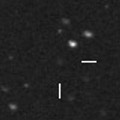
|
It is expected to reach up to 10 mag and to be observable in good condition in 2010 spring. Now it is not observable. It will appear in the morning sky at 13 mag in late January.
Date(TT) R.A. (2000) Decl. Delta r Elong. m1 Best Time(A, h)
Dec. 5 17 7.58 -32 49.5 3.398 2.440 11 14.5 18:18 ( 63,-19)
Dec. 12 17 16.18 -31 29.2 3.340 2.370 8 14.4 5:28 (294,-22)
|
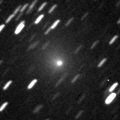
|
It brightened up to 8.5 mag in May and June (May 26, Juan Jose Gonzalez). Now it is fading. It was still bright as 11.6 mag in October (Oct. 10, Marco Goiato). However, it is already too faint to see visually. It will never be observable again in the Northern Hemisphere. In the Southern Hemisphere, it will be low temporarily in winter, but it keeps observable until when it fades out.
Date(TT) R.A. (2000) Decl. Delta r Elong. m1 Best Time(A, h)
Dec. 5 18 4.49 -51 50.6 3.510 2.739 33 14.4 18:18 ( 40,-20)
Dec. 12 18 22.42 -50 59.8 3.617 2.816 30 14.6 18:19 ( 42,-21)
|
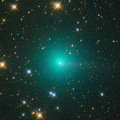
|
It brightened up to 6.7 mag in June (June 9, Marco Goiato). Now it is 13.3 mag (Nov. 7, Ken-ichi Kadota), a bit brighter than this ephemeris. It must be visible visually still now. It will be fading after this, and keeps observable until next spring when it becomes fainter than 18 mag.
Date(TT) R.A. (2000) Decl. Delta r Elong. m1 Best Time(A, h)
Dec. 5 13 39.63 17 54.1 3.051 2.709 60 14.5 5:23 (278, 42)
Dec. 12 13 41.29 19 51.3 2.988 2.769 67 14.7 5:28 (281, 49)
|
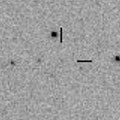
|
Now it is 15.7 mag (Sept. 19, Hidetaka Sato). It will be 14 mag from winter to spring in 2010. But the condition is bad. Now it is not observable in the Northern Hemisphere. But in the Southern Hemisphere, it keeps observable until mid January. In the Northern Hemisphere, it will appear in the morning sky at 15 mag in late May in 2010, then it keeps observable while fading gradually after that.
Date(TT) R.A. (2000) Decl. Delta r Elong. m1 Best Time(A, h)
Dec. 5 20 24.14 -44 8.0 2.405 1.918 49 14.6 18:18 ( 29, 2)
Dec. 12 20 42.33 -41 4.7 2.424 1.886 46 14.6 18:19 ( 32, 4)
|
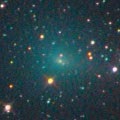
|
It brightened up to 8.8 mag in May and June (May 19, Juan Jose Gonzalez). Now it is still bright as 12.0 mag (Nov. 13, Marco Goiato). However, it will be too faint to see visually soon. It keeps observable in the evening sky for a long time until next spring when it becomes fainter than 18 mag.
Date(TT) R.A. (2000) Decl. Delta r Elong. m1 Best Time(A, h)
Dec. 5 23 20.63 -9 44.5 2.103 2.388 94 14.9 18:24 ( 0, 45)
Dec. 12 23 28.76 -8 42.7 2.231 2.430 89 15.1 18:19 ( 5, 46)
|
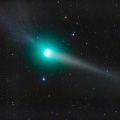
|
It passed near by the earth in late February, and it reached up to 4.9 mag (Feb. 23, Juan Jose Gonzalez). Now it is fading, but still bright as 15.5 mag (Nov. 14, Ken-ichi Kadota). It is observable at 15 mag in good condition until winter.
Date(TT) R.A. (2000) Decl. Delta r Elong. m1 Best Time(A, h)
Dec. 5 5 56.08 21 26.5 3.390 4.345 163 15.2 1:02 ( 0, 76)
Dec. 12 5 44.13 21 23.0 3.435 4.414 173 15.3 0:23 ( 0, 76)
|

|
It brightned up to 10 mag from late 2008 to early 2009. Now it is fading. But it is still bright as 15.3 mag (Nov. 2, Ken-ichi Kadota). It will be observable in good condition again in winter at 15 mag. Then it may be still visible visually.
Date(TT) R.A. (2000) Decl. Delta r Elong. m1 Best Time(A, h)
Dec. 5 10 27.52 5 3.4 4.897 5.097 96 15.2 5:23 (355, 60)
Dec. 12 10 27.49 4 37.4 4.840 5.151 103 15.2 5:05 ( 0, 60)
|
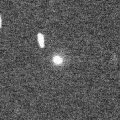
|
New periodic comet. Brightening very rapidly. Now it is 15.7 mag (Nov. 15, Ken-ichi Kadota). It will brighten up to 15 mag and will be observable in good condition in winter.
Date(TT) R.A. (2000) Decl. Delta r Elong. m1 Best Time(A, h)
Dec. 5 1 46.25 -1 39.4 1.010 1.809 130 15.2 20:49 ( 0, 53)
Dec. 12 1 51.70 -3 42.4 1.050 1.792 123 15.2 20:27 ( 0, 51)
|
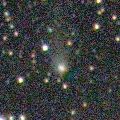
|
It brightened up to 11.5 mag in last summer (Aug. 4, Marco Goiato). Now it is 15.6 mag (Oct. 31, Hidetaka Sato). It keeps observable in good condition for a long time in the Southern Hemisphere. Now it became observable again also in the Northern Hemisphere. It will keep 15-16 mag until next spring.
Date(TT) R.A. (2000) Decl. Delta r Elong. m1 Best Time(A, h)
Dec. 5 5 34.99 -42 2.9 4.140 4.638 114 15.2 0:41 ( 0, 13)
Dec. 12 5 25.64 -41 19.1 4.180 4.690 115 15.3 0:04 ( 0, 14)
|
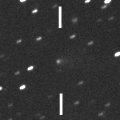
|
Now it is 15.2 mag, already visible visually (Nov. 24, Juan Jose Gonzalez). It will be observable at 15 mag in good condition in winter and spring.
Date(TT) R.A. (2000) Decl. Delta r Elong. m1 Best Time(A, h)
Dec. 5 5 18.90 13 7.5 1.243 2.216 167 15.5 0:25 ( 0, 68)
Dec. 12 5 13.06 13 20.3 1.210 2.186 170 15.3 23:47 ( 0, 68)
|
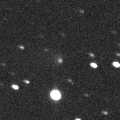
|
Now it is 16.4 mag (Nov. 3, Ken-ichi Kadota). It will reach up to 12 mag in 2012, and will be observable visually at 12-13 mag for a long time from 2011 to 2013. In 2009, it is observable in good condition at 16 mag from summer to autumn. In the Northern Hemisphere, the comet will be low around its brightest seasons.
Date(TT) R.A. (2000) Decl. Delta r Elong. m1 Best Time(A, h)
Dec. 5 21 37.66 -1 3.9 8.305 8.088 73 15.7 18:18 ( 37, 47)
Dec. 12 21 37.62 -1 13.3 8.387 8.052 66 15.7 18:19 ( 46, 43)
|
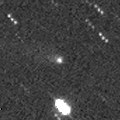
|
Getting higher again in the morning sky. It will be observable at 15-16 mag in good condition from winter to spring.
Date(TT) R.A. (2000) Decl. Delta r Elong. m1 Best Time(A, h)
Dec. 5 15 41.45 21 23.8 3.464 2.875 46 15.8 5:23 (257, 19)
Dec. 12 15 42.77 20 59.6 3.433 2.894 49 15.8 5:28 (261, 25)
|

|
It brightened up to 13 mag and observed visually from 2007 to 2009. Due to the far distance, it is bright as 15.5 mag still now (Oct. 30, Ken-ichi Kadota). It will be observable in good condition again from winter to spring.
Date(TT) R.A. (2000) Decl. Delta r Elong. m1 Best Time(A, h)
Dec. 5 13 27.82 31 11.6 7.671 7.417 71 16.1 5:23 (262, 50)
Dec. 12 13 28.33 31 40.0 7.604 7.448 77 16.1 5:28 (264, 57)
|

|
It was observed as 15-16 mag in early 2009. In 2010, it will be observable at 15.5 mag in good condition from winter to spring.
Date(TT) R.A. (2000) Decl. Delta r Elong. m1 Best Time(A, h)
Dec. 5 13 13.37 -1 42.1 4.051 3.585 55 16.1 5:23 (302, 35)
Dec. 12 13 20.36 -2 19.0 3.966 3.588 60 16.1 5:28 (309, 39)
|
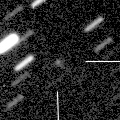
|
Now it is 16.7 mag (Nov. 15, Catalina Sky Survey). It will be observable at 15.5 mag in the evening sky from winter to spring.
Date(TT) R.A. (2000) Decl. Delta r Elong. m1 Best Time(A, h)
Dec. 5 2 13.64 29 5.6 1.144 2.033 145 16.4 21:15 ( 0, 84)
Dec. 12 1 55.19 31 16.5 1.145 1.968 134 16.2 20:29 ( 0, 86)
|
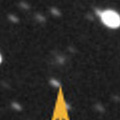
|
Now it is 17.1 mag (Nov. 15, Ken-ichi Kadota). The condition of this apparition is bad. It will reach up to 11-12 mag from spring to autumn in 2010, but it is not observable. It will be getting brighter gradually in the evening sky, but it will be too low to observe in January at 15 mag.
Date(TT) R.A. (2000) Decl. Delta r Elong. m1 Best Time(A, h)
Dec. 5 21 0.55 -1 53.6 2.733 2.484 65 16.4 18:18 ( 48, 42)
Dec. 12 21 9.75 -1 39.6 2.766 2.436 60 16.3 18:19 ( 53, 39)
|

|
It passed the perihelion in September, and brightened up to 14.6 mag (Sept. 19, Hidetaka Sato). It is fading now, but still bright as 16.1 mag (Nov. 11, Hidetaka Sato). It keeps observable in good condition until February when it becomes fainter than 18 mag.
Date(TT) R.A. (2000) Decl. Delta r Elong. m1 Best Time(A, h)
Dec. 5 22 5.54 3 41.2 1.450 1.639 82 16.4 18:18 ( 31, 55)
Dec. 12 22 20.72 6 31.4 1.562 1.695 79 16.6 18:19 ( 39, 56)
|
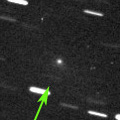
|
It brightened up to 11 mag in outburst in 2003. However, it does not seem to be so bright in this apparition. Now it is 16.3 mag (Nov. 18, J. M. Ruiz, G. Muler). It will be observable in good condition in winter. But it seems to brighten only up to 16 mag.
Date(TT) R.A. (2000) Decl. Delta r Elong. m1 Best Time(A, h)
Dec. 5 23 35.44 9 35.9 1.044 1.611 105 16.5 18:39 ( 0, 65)
Dec. 12 23 44.24 9 56.3 1.063 1.572 100 16.4 18:20 ( 0, 65)
|
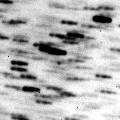
|
The condition is good in this apparition. It approached to the earth down to 0.38 A.U., and brightened up to 15.9 mag (Nov. 24, A. Sanchez). It will fading after this. It will be fainter than 18 mag in mid January.
Date(TT) R.A. (2000) Decl. Delta r Elong. m1 Best Time(A, h)
Dec. 5 23 36.67 2 41.3 0.416 1.152 102 16.5 18:42 ( 0, 58)
Dec. 12 0 18.86 6 15.8 0.457 1.199 106 16.6 18:56 ( 0, 62)
|

|
Now it is 18.0 mag (Nov. 21, C. Rinner, F. Kugel). It will be brightening rapidly after this. It will reach up to 15 mag from winter to spring, and will be observable in good condition.
Date(TT) R.A. (2000) Decl. Delta r Elong. m1 Best Time(A, h)
Dec. 5 10 16.19 17 21.2 1.948 2.373 103 16.7 5:21 ( 0, 72)
Dec. 12 10 23.12 17 11.0 1.853 2.358 108 16.5 5:00 ( 0, 72)
|
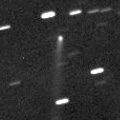
|
Now it is 16.1 mag (Nov. 3, Ken-ichi Kadota). It has a very long tail in spite of the distance. It passed the perihelion in 2009, but it was brighter in 2008. It will be fading after this, and will be fainter than 18 mag in next spring.
Date(TT) R.A. (2000) Decl. Delta r Elong. m1 Best Time(A, h)
Dec. 5 22 54.72 31 22.6 3.728 4.069 103 16.6 18:18 ( 51, 84)
Dec. 12 22 54.98 31 32.2 3.839 4.087 97 16.7 18:19 ( 75, 79)
|
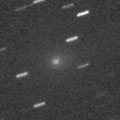
|
Fading slowly. Now it is 16.6 mag (Nov. 15, Catalina Sky Survey). It keeps observable in good condition until February when it becomes fainter than 18 mag.
Date(TT) R.A. (2000) Decl. Delta r Elong. m1 Best Time(A, h)
Dec. 5 10 15.91 9 14.9 1.981 2.365 100 16.6 5:21 ( 0, 64)
Dec. 12 10 17.34 8 40.2 1.943 2.420 106 16.7 4:55 ( 0, 64)
|
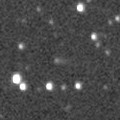
|
Now it is 16.5 mag (Nov. 10, R. Benavides). This comet tends to brighten after the perihelion passage. It will be observable at 16-17 mag in 2010 and 2011.
Date(TT) R.A. (2000) Decl. Delta r Elong. m1 Best Time(A, h)
Dec. 5 4 40.16 24 51.9 2.217 3.202 177 16.8 23:42 ( 0, 80)
Dec. 12 4 35.17 24 36.8 2.222 3.198 170 16.8 23:09 ( 0, 80)
|
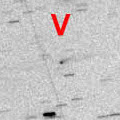
|
New periodic comet discovered very near by 29P/Schwassmann-Wachmann 1 and 81P/Wild 2. Now it is 17.2 mag (Nov. 3, Ken-ichi Kadota). It keeps observable in good condition at 17 mag for a while until winter.
Date(TT) R.A. (2000) Decl. Delta r Elong. m1 Best Time(A, h)
Dec. 5 10 50.42 12 38.3 1.571 1.908 93 17.0 5:23 (340, 66)
Dec. 12 10 58.42 13 1.1 1.534 1.949 99 17.0 5:28 (355, 68)
|
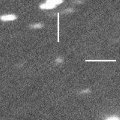
|
Now it is 17.4 mag (Nov. 6, C. Rinner, F. Kugel). It keeps observable at 17 mag for a long time from 2010 to 2012.
Date(TT) R.A. (2000) Decl. Delta r Elong. m1 Best Time(A, h)
Dec. 5 2 43.68 18 36.4 7.796 8.673 151 17.3 21:46 ( 0, 74)
Dec. 12 2 38.95 18 21.1 7.851 8.658 143 17.3 21:13 ( 0, 73)
|
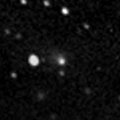
|
It brightened up to 15-16 mag in 2008 summer. Now it is 17.2 mag (Oct. 26, J. Gonzalez). It keeps observable at 17 mag in good condition for a long time until winter.
Date(TT) R.A. (2000) Decl. Delta r Elong. m1 Best Time(A, h)
Dec. 5 3 12.16 34 57.2 2.350 3.275 156 17.4 22:14 ( 0, 90)
Dec. 12 3 7.65 34 33.0 2.405 3.293 149 17.5 21:42 ( 0, 90)
|
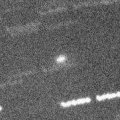
|
It was bright as 16.8 mag in November (Nov. 14, Ken-ichi Kadota). Now it is fading. It will be fainter than 18 mag in late December.
Date(TT) R.A. (2000) Decl. Delta r Elong. m1 Best Time(A, h)
Dec. 5 1 21.03 23 3.4 1.535 2.322 133 17.6 20:22 ( 0, 78)
Dec. 12 0 54.85 21 26.7 1.653 2.308 120 17.7 19:28 ( 0, 76)
|
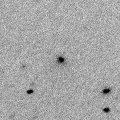
|
It was originally predicted to be 19 mag. However, it brightened rapidly and reached up to 15.7 mag in October (Oct. 24, L. Donato, V. Gonano, E. Guido, V. Santini, G. Sostero). However, it is fading rapidly now. It has already faded down to 17.9 mag (Nov. 21, Ken-ichi Kadota).
Date(TT) R.A. (2000) Decl. Delta r Elong. m1 Best Time(A, h)
Dec. 5 0 33.62 11 55.8 1.562 2.218 119 17.6 19:36 ( 0, 67)
Dec. 12 0 37.25 12 44.9 1.642 2.225 113 17.8 19:13 ( 0, 68)
|

|
It will be observable at 17.5 mag in good condition in winter.
Date(TT) R.A. (2000) Decl. Delta r Elong. m1 Best Time(A, h)
Dec. 5 9 58.60 29 39.2 2.516 3.007 110 17.8 5:04 ( 0, 85)
Dec. 12 10 2.10 30 9.4 2.439 3.013 116 17.7 4:40 ( 0, 85)
|

|
It will be observable at 17.5 mag in good condition in early 2010 and early 2011.
Date(TT) R.A. (2000) Decl. Delta r Elong. m1 Best Time(A, h)
Dec. 5 5 48.64 20 14.5 2.663 3.624 165 17.8 0:55 ( 0, 75)
Dec. 12 5 43.75 20 17.4 2.636 3.615 173 17.8 0:22 ( 0, 75)
|

|
New periodic comet which brightened up to 14 mag in 2004 and 2005. It should be observable at 18 mag also around the aphelion. However, no observations have been reported since 2008 January. It seems to have faded out rapidly. Now it is fainter than 20.4 mag actually (Sept. 16, Leonid Elenin).
Date(TT) R.A. (2000) Decl. Delta r Elong. m1 Best Time(A, h)
Dec. 5 7 2.41 29 9.7 4.141 5.008 148 17.8 2:08 ( 0, 84)
Dec. 12 6 58.45 29 30.2 4.084 5.001 156 17.8 1:37 ( 0, 84)
|
|
![]()
 157P/Tritton
157P/Tritton 107P/(4015) Wilson-Harrington
107P/(4015) Wilson-Harrington 94P/Russell 4
94P/Russell 4 C/2008 P1 ( Garradd )
C/2008 P1 ( Garradd ) 64P/Swift-Gehrels
64P/Swift-Gehrels 203P/2008 R4 ( Korlevic )
203P/2008 R4 ( Korlevic ) P/2009 U6 ( LINEAR )
P/2009 U6 ( LINEAR ) C/2008 S3 ( Boattini )
C/2008 S3 ( Boattini ) 47P/Ashbrook-Jackson
47P/Ashbrook-Jackson C/2009 T3 ( LINEAR )
C/2009 T3 ( LINEAR ) 127P/Holt-Olmstead
127P/Holt-Olmstead P/2009 W1 ( Hill )
P/2009 W1 ( Hill ) 31P/Schwassmann-Wachmann 2
31P/Schwassmann-Wachmann 2 P/2004 F3 ( NEAT )
P/2004 F3 ( NEAT )![]()




































